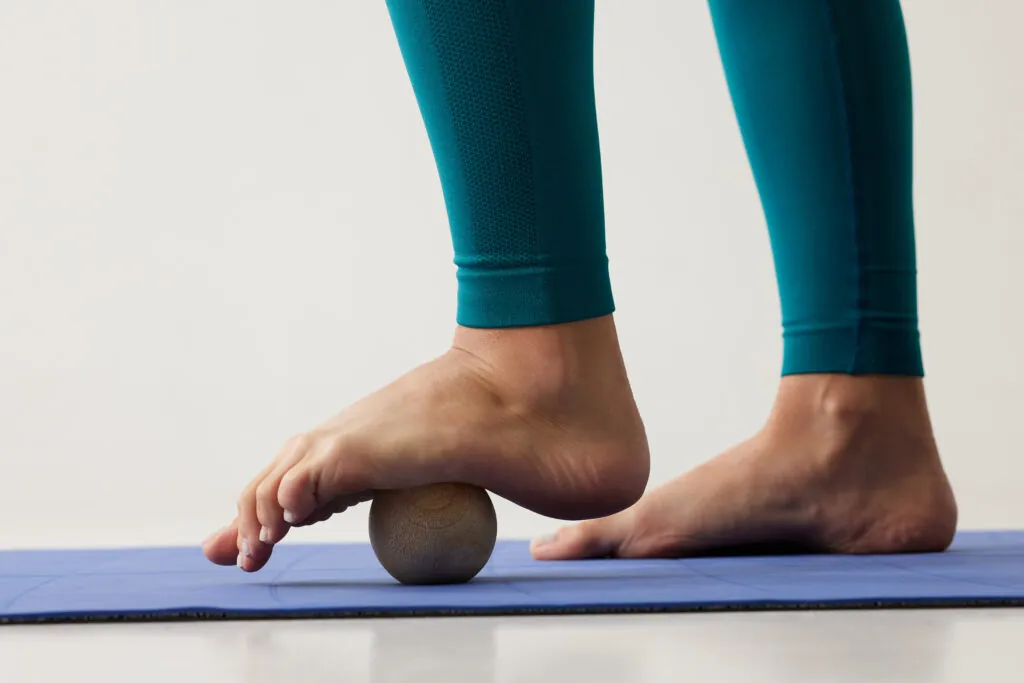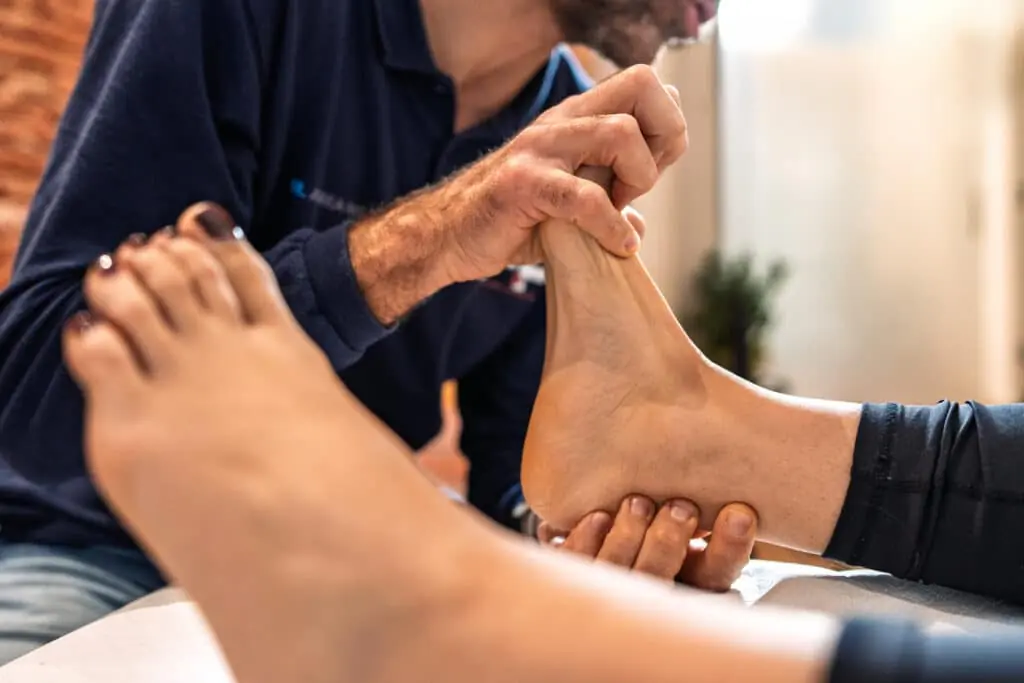[tsf_breadcrumb sep="/" class="breadcrumbs]
Home / Patients / Conditions We Treat / Plantar Fasciitis
Pain in the heel, along the arch, or at the ball of your foot can mean you may have plantar fasciitis, a common foot condition. Our therapists are trained to work with patients to reduce pain and restore their walking ability. Patients work with their physical therapist to develop a personalized treatment plan. Your treatment plan may include:
Plantar fasciitis is one of the most common musculoskeletal conditions, in fact it is estimated that 1 in 10 people will develop plantar fasciitis at some point in their life.1 The root cause of plantar fasciitis is inflammation of the plantar fascia, which is a thick band of connective tissue that runs along the bottom of your foot, from your heel to the base of your toes. The function of the plantar fascia is to provide shock absorption as we move and because of this it endures small tears which can lead to inflammation and pain. Plantar fasciitis is typically characterized by sharp or stabbing pain located in your heel.2 This pain is generally worse during the first few steps after a prolonged period of rest and lessens as you move. 2
Although plantar fasciitis can occur in any demographic, there are some predisposing factors. It is most common among individuals aged 40-60, as well as obese individuals.2 It is also common in runners or those who engage in repetitive high intensity activity. In fact, it accounts for 10% of running-related injuries. Occupations, such as medical staff or factory workers, are also at an increased risk of developing plantar fasciitis due to prolonged periods of time on their feet.
Plantar fasciitis can significantly impair an individual’s mobility and overall quality of life. An individual suffering from plantar fasciitis might find it challenging to walk, exercise, or perform work related tasks. This can lead to a sedentary lifestyle which lends itself to the development of other harmful conditions as well as the development of chronic pain, compensatory movements or development of knee or hip pain.

Plantar fasciitis is typically caused by excessive stress that leads to pain within the foot. Common contributing factors include:1
There are several risk factors that contribute to an individual’s likelihood of developing plantar fasciitis. Some of which include:
In addition to the risk factors stated above, there are numerous underlying conditions that predispose an individual to developing plantar fasciitis. These include but are not limited to:
Individuals with plantar fasciitis typically experience a distinct set of symptoms that aid in diagnosis.3 Although symptoms can vary in intensity, plantar fasciitis often follows a recognizable pattern. One of the most common characteristics of plantar fasciitis is heel pain that is worse upon taking your first few steps in the morning, after prolonged periods of non-weight bearing activity, or at the onset of a workout. It is often described as a sharp, stabbing, or aching pain that is located at the anterior medial heel and often improves with mild activity. Pain is noticeably worse when barefoot or walking/standing on a hard surface as well as when climbing stairs. Limited dorsiflexion, which is caused by a tight achilles tendon or calf muscle, is also a common symptom of plantar fasciitis and can cause an individual to feel tightness or stiffness in the calf muscles.
Although diagnosis of plantar fasciitis can often be made based upon clinical presentation alone, ultrasound is the most commonly used modality in identifying plantar fasciitis as it can reveal thickening or inflammation of the plantar fascia.3 X-rays are also often used to rule out the possibility of bone spurs or fractures. MRIs are less commonly used but might be used in complex or chronic cases to thoroughly evaluate the soft tissue and structures of the foot.
A physical therapist (PT) can aid in the diagnosis of plantar fasciitis by completing a clinical evaluation that is based upon symptom presentation and physical examination. A thorough PT evaluation includes obtaining a detailed history of symptoms, including onset, duration, activity level, as well as aggravating and alleviating factors. The PT will also conduct a physical exam which includes palpation of the foot, gait analysis, strength and range of motion (ROM) assessment of the lower extremity as well as an evaluation of foot alignment and arch height. Additionally, a PT will conduct functional tests such as heel or toe walking to determine how particular movement patterns affect pain. The most common differential diagnosis test a PT conducts during an evaluation is the Windlass test.3 The Windlass test is conducted by passively extending the great toe while the patient is seated or standing. A positive test elicits heel pain or reveals limited toe extension, indicating tension in the plantar fascia.

The prime focus of plantar fasciitis treatment is pain and load management, promoting healing of the plantar fascia, and addressing the underlying causes such as tight muscles. Most cases of plantar fasciitis respond well to conservative treatments however, in chronic more persistent cases, advanced interventions such as surgery are required. The following sections outline both non-surgical and surgical treatments options.
Find a PT Clinic Near You!
Physical therapists play a key role in the treatment of plantar fasciitis.3 One of the most important components of plantar fasciitis management is patient education. Unfortunately, plantar fasciitis is not a condition that will go away overnight and timely initiation of conservative management is important. This includes, rest, icing, and stretching of the calf and plantar muscles. Other non-surgical treatment options that are initiated by PTs include:
Surgical treatment for plantar fasciitis is considered in cases where conservative treatments fail to improve symptoms. These procedures aim to relieve tension in the plantar fascia and address any other structural issues that might be contributing to chronic pain. The two most common surgical procedures include a Plantar Fascia Release and Gastrocnemius Recession.


Preventing plantar fasciitis involves a combination of maintaining a healthy body weight, avoiding overuse by being mindful of activity levels, utilizing proper footwear, and being aware of how much stress is applied to your feet throughout the day. Another key to reducing strain on the plantar fascia is load management. It is important to gradually increase activity intensity and avoid sudden spikes in physical demands. For example, if you are ramping up to run a marathon, it is best to follow a program that gradually increases distance to reduce risk of developing plantar fasciitis. Appropriate footwear also plays a crucial role in preventing plantar fasciitis however, there is no one-size-fits-all solution. If you are unsure which shoes are best suited for you it might be worth making an appointment with an orthopedist or podiatrist.
In general, a shoe that provides good arch support, a cushioned heel, firm and flexible midsole, and a secure fit are optimal for someone suffering from plantar fasciitis. However, the best footwear is whatever feels most supportive and comfortable to the individual based upon their specific needs.
Living with plantar fasciitis can be challenging and affect one’s daily life however, with the proper approach and compliance with the individualized treatment plan provided by a PT, most individuals can manage their symptoms and return to their prior level of function. Each individual’s condition, lifestyle, and response to treatment varies and this is why a personalized treatment plan is essential. Seeking assistance from a skilled PT can help ensure proper diagnosis and provide patient specific management of plantar fasciitis. Along with the guidance provided by a PT, individuals should take an active role in treatment by making thoughtful choices about their activity levels, footwear, and overall health in order to maintain long-term health and well-being.

As mentioned previously, PTs play a vital role in the treatment of plantar fasciitis as they provide patient centered and personalized treatment plans that address the individual’s unique symptoms and goals. This is done by addressing the root causes of pain, improving mobility, and promoting long-term healing all while considering the unique goals of the individual. The clinics under Confluent Health utilize a patient-centered and evidence-based approach to the treatment of plantar fasciitis. Their model emphasizes functional movement assessments and hands-on care, with a primary goal of long-term pain relief and injury prevention.
A skilled PT will guide you through some of the following treatment strategies based upon your individualized goals and needs:
The overall goal of physical therapy in the management of plantar fasciitis is pain management and restoration of normal movement and function in the foot. By empowering patients with the right tools such as an individualized treatment plan and knowledge surrounding the condition, PTs offer an effective and sustainable path to recovery.
If you’re living with heel pain or suspect you might have plantar fasciitis, don’t wait for it to get worse- early intervention for the treatment of plantar fasciitis is crucial. The PTs at our clinics offer proven, personalized solutions to help you manage and treat plantar fasciitis. Take control of your foot health by connecting with a licensed PT who will take your needs and goals into consideration. To find a clinic near you and schedule an appointment. We look forward to treating you soon!
Acute: Early stage form of plantar fasciitis. Is typically characterized by sharp heel pain, especially with first steps in the morning. Often results from recent overuse and will often resolve with rest and conservative treatments.
Chronic: Pain that persists several months and may shift from sharp pain to a dull and aching discomfort. Are often due to biomechanical issues, poor load management, or lack of appropriate treatment.